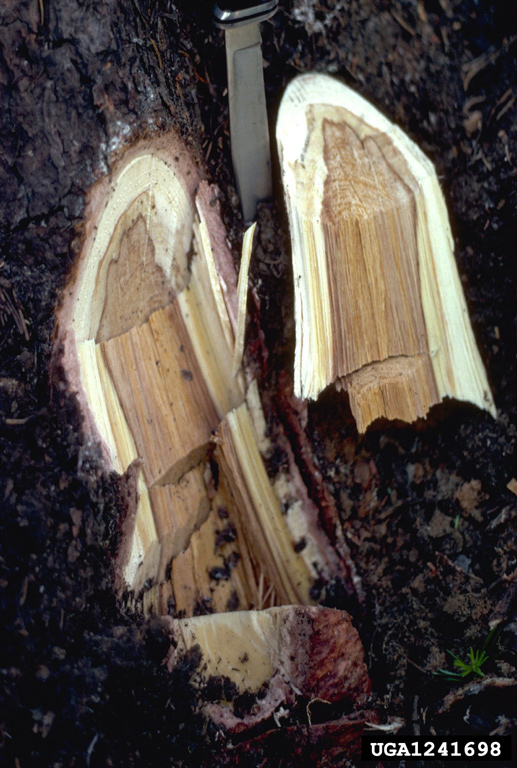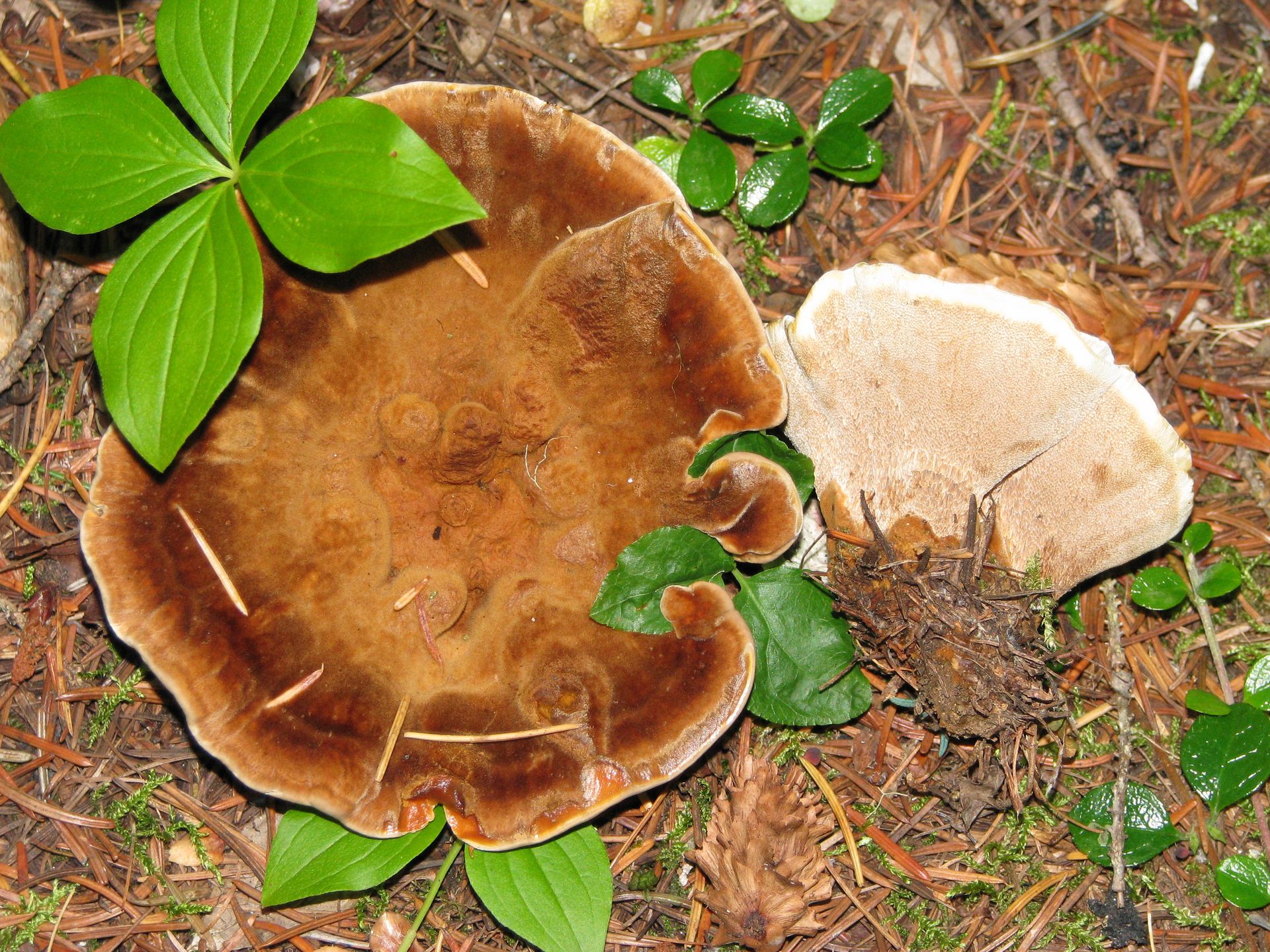Tomentosus Root Rot
Onnia tomentosa
Key Wildlife Value:
Tomentosus root rot creates short-term snags of any size and all sizes of down wood, by killing and decaying the root system and butts of host trees. Substantial concentrations of down wood, useful habitat for many species of wildlife, are likely occur in O. tomentosa infection areas, usually with a corresponding decrease in canopy cover. Canopy gaps created by tomentosus root rot expand very slowly, resulting in a more diverse stand structure and at times a more diverse plant species composition, as non-host trees, shrubs, and forbs are released or become established from the infection center outward, following the slowly expanding fringe of dying host trees. Bark beetles and woodborers frequently are attracted to trees infected with root disease, providing good foraging habitat for woodpeckers.
Distribution in Oregon and Washington:
Found primarily in the Blue Mountains and the high Cascades. (See also Important Habitats and Spread Dynamics)
Hosts:
Engelmann spruce is the most common host. Sitka spruce, Pacific silver fir, grand fir, white fir, lodgepole pine, ponderosa pine, and Douglas-fir are occasionally infected.
Diagnosis:
O. tomentosa can difficult to detect, as crown symptoms are not common and the short-lived fruiting bodies are sometimes infrequently or seldom produced, especially in the Blue Mountains. Diagnosis of tomentosus root rot usually is best performed by examining the broken roots of windthrown trees or by chopping into the roots of standing suspect snags and living trees. Look for advanced decay in the heartwood that is firm, dry, and pitted or honeycombed in appearance.



When present, the characteristic fruiting bodies and decay also can be used to aid diagnosis. Fruiting bodies are annual, yellow-brown, leathery mushrooms that typically range in diameter from 2.5 - 11 cm, or 1 - 4 in.

In young stands regenerated following harvest activities, look for a pattern of dead or missing trees associated with large stumps. Stumps will have evidence of infection by O. tomentosa in the roots and butt. In more mature stands with a high component of Engelmann spruce and other susceptible hosts, look for patches of forest that have a more open canopy than the surrounding stand and standing dead trees. Windthrown trees are especially common in tomentosus root rot pockets, and will have “rootballs” and roots with characteristic decay caused by O. tomentosa. Less susceptible conifers and hardwoods may sometimes populate an infection area, mitigating the effects of the root disease upon canopy cover. Live trees infected with the root disease may display one or more the following symptoms: shortened terminal growth, sparse foliage, small needles, chlorosis (yellowing), and stress cone crops. O. tomentosa most commonly develops infection centers rather than diffuse distributions.
Life History:
O. tomentosa lives in the roots and butts of host trees. The fungus grows across root contacts to invade the root tissues of new hosts. Once roots become infected, the fungus eventually spreads to the root collar where it colonizes the heartwood in the butt of the tree. Annual fruiting bodies appear during moist late summers or in the fall after periods of wet weather, producing spores that are capable of infecting wounded roots. Fungal growth decays the roots and kills trees slowly. Trees usually do not die until they have been infected for 15 to 20 years. They are frequently windthrown before dying, and often contain large amounts of decay in their bases, which may extend 3 to 6 feet above ground level. Once infected trees die, the fungus may continue to live in large stumps, boles, and large roots for at least 20 years.
Most fires have little effect on the survival of O. tomentosa on a site. Only those fires intense enough to destroy entire root systems are detrimental. Fire, however, sometimes may favor site occupancy by less-susceptible species, reducing the expression and expansion of disease.
Important Habitats and Spread Dynamic:
Tomentosus root rot is most prevalent in localized areas in the Blue Mountains and the high Cascades, being relatively uncommon elsewhere in Oregon and Washington. It is most commonly found in stands more than 40 years old, but may affect trees of any age. Continuous cover of highly susceptible species provides favorable habitat, especially when large infected stumps are also present. The stumps and dead roots created during thinning and other partial cutting activities in infected stands are thought to increase inoculum levels, enhancing survival and spread of the pathogen. Tomentosus root rot usually intensifies when infection centers and adjacent areas are regenerated with spruce.
O. tomentosa spreads via ectotrophic mycelium across root-to-root contacts between infected and uninfected host trees. It can enter trees through dead roots, and can penetrate the bark of very small roots. Long-distance or localized spread caused by spore infection of wounded roots may occur, but is poorly understood. Colonized stumps and infected trees serve as “centers” of gradually expanding root disease infection areas as the fungus slowly moves down colonized tree roots and up the roots of previously uninfected individuals. Tomentosus root rot typically occurs in small patches of trees with 2 to 5 trees per patch. Infection centers expand very slowly, at an estimated rate averaging 13 cm (5 in) or less per year. In severely diseased areas, small patches of infected trees can coalesce into larger areas of infected trees interspersed with uninfected trees.
Opportunities for Manipulation to Increase Wildlife Habitat:
Buffered areas that include entire tomentosus root rot infection centers with some surrounding non-infected area may be retained in managed stands to provide a steady supply of short-term snags and down wood. Buffers should extend at least 3 m from known inoculum sources. Non-host buffers may require periodic maintenance to prevent unintended spread of the root disease into other areas of the stand. This approach would be appropriate for stands where root disease infection centers were discreet and not diffuse, and for stands being converted to non-host species.
Potential Adverse Effects:
O. tomentosa causes tree mortality, growth loss, and extensive butt rot, especially of Engelmann spruce. On recreational and administrative sites, forest work sites, and along roadsides, trees with tomentosus root disease have a high potential for failure and can present a significant safety hazard.
How to Minimize the Risk of Adverse Effects:
When regenerating stands infected with O. tomentosa, establish less susceptible species in infection centers and in a 3 m (10 ft) buffer area around infection centers. Areas outside of the infection centers and buffer areas may be planted with susceptible species, or preferably, a mixture of species that would decrease the incidence of root contact between susceptible hosts. Inoculum removal (stump and root removal) may be an effective strategy in some situations, but is expensive and involves intense use of heavy equipment, which carries a risk of significant negative effects upon subsequent tree growth. On recreational and administrative sites, forest work sites, and along prioritized roadsides, infected trees within striking distance of a target should be removed or topped to a safe height, or the situation arranged so that people are not exposed to danger.
References
Goheen, E.M. and E.A. Willhite. 2006. Field guide to common diseases and insect pests of Oregon and Washington conifers. USDA Forest Service, Pacific Northwest Region, Portland, OR. R6-NR-FID-PR-01-06. 335 pp. http://www.biodiversitylibrary.org/bibliography/80321#/summary
Hadfield, J.S., D.J. Goheen, G.M. Filip, C.L. Schmitt, and R.D. Harvey. 1986. Root diseases in Oregon and Washington conifers. USDA Forest Service, Pacific Northwest Region, Portland, OR. R6-FPM-250-86. 27 pp.
Hansen, E.M. and K.L. Lewis, eds. 1997. Compendium of conifer diseases. American Phytopathological Society Press. 101 pp.
Lewis, K.J., and B.S. Lindgren. 2002. Relationship between spruce beetle and tomentosus root disease: two natural disturbance agents of spruce. Can. J. For. Res. 32:31-37. http://web.unbc.ca/~lindgren/pdf/lewis_lindgren.pdf